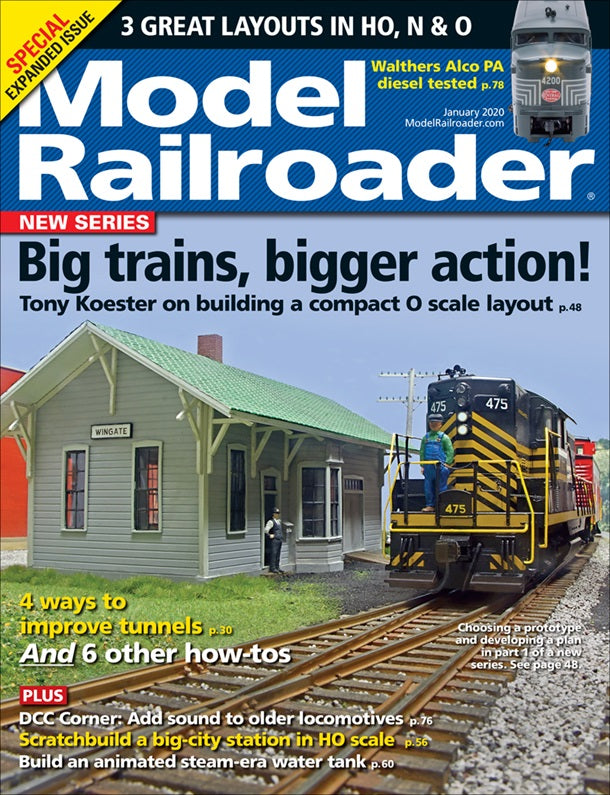Resources
About & Contact Us


Model Railroader - Magazine - Vol. 87 - Issue 01 - Jan. 2020
- Price
- $ 9.99
Product Information
- Vol. 87
- Issue: 1
- Release: January 2020
- Series: Model Railroader
- Publisher: Kalmbach
Digging into better tunnels
by Jim Richards
Four tips to improve an often necessary scenic feature
Tunnels help solve a number of track planning issues. Jim Richards wasn’t only concerned with making the tunnels on his Athabaska RR look better; he also wanted to improve performance. So, in addition to making his own portals and tunnel liners, Jim also experimented with hiding his sound-equipped locomotives sonically as well.
N scale Gauley Shavers Fork track plan
Power pickups for rolling stock
by Jon Fruth
Phosphor-bronze wire makes areliable electrical pickup for interior and exterior car lighting systems
Adding interior lighting or end-of-train markers to a caboose or other car adds realism. Rather than using an onboard battery, I prefer to use track wipers that conduct electricity from the rails to power the car’s lights. I use low-friction phosphor-bronze wire as wipers that ride against the metal wheels of my illuminated rolling stock to pick up track power. Fine magnet wire leads, soldered to the phosphor-bronze wire, carry the electricity to the interior and exterior lighting circuits.
Backdating Quisling, Calif.
Adapting a 1980s modular layout to represent the 1950s
In the December 2018 Model Railroader, I was pleased to present my 24-foot-long HO scale modular layout, Quisling, Calif. Living in Plymouth, England, I wrote the article in part to showcase our model railroad club’s small part in the ever-growing international interest in modular modeling.
Quisling, Calif. (1954) track plan
Kitbash a fishing fleet
by Jim Richards
Ship models in various scales provide the raw materials for this HO scale project
Model railroaders are drawn to waterfront scenes like bees to nectar. A wharfside setting with boats, freight cars, and industry can’t be surpassed for atmosphere, a sense of bustling activity, and visual proof of the link between two different freight-handling systems.
Building the Wingate in O scale
by Tony Koester
PART 1: Choosing a prototype and developing a plan for a compact one-town railroad
Let’s face it: For many model railroaders, the cliché about not getting any younger is no longer a laughing matter. Contrary to the laws of physics, smaller scale models are shrinking before our very eyes. Detail that used to pop out has mysteriously vanished. Hands that were steady enough to do neurosurgery now automatically stir our coffee. And eyes that could read the road number on an N scale boxcar at 10 paces now require reading glasses just to sign checks. Doesn’t sound like you? Your time will come, probably sooner than you think.
O scale Wingate track plan
Scratchbuild a big-city station
by Thomas Oxnard
Kansas City Union Station inspired this freelanced HO scale structure
In 2018 I attended the National Model Railroad Association National Convention in Dansas City, Mo. Across the street from the convention hotel was Kansas City Union Station. The structure, opened in 1914, was designed and built in the Beaux Arts style. It was a hub for freight and passenger service. After a period of decline and closure, it was restored in 1999. Today, the station is served by long-distance and regional Amtrak trains and is also home to restaurants, museums, and a large ballroom for events and exhibits.
Build a working water tower
by Donald M. Deuell
Plans from a 1950s Model Railroader article were modified to change scales and add an operating spout driven by a slow-motion switch motor
This is a story about a water tank. It began more than 60 years ago, with an excellent article featuring scale drawings titled “Water Tank” by Eric Stevens in the March 1952 Model Railroader. Over the years, I’ve built several HO versions that still reside on my layout.
How to model a chain link fence
by Pelle Søeborg
Create an HO scale fence in just a few steps
One of the rail-served businesses on my HO scale Union Pacific layout needed a chain link fence to keep trespassers off the property. I used the Walthers chainlink fence kit as a starting point, but combined it with Detail Associates .019" brass wire and Scale Scenics brass mesh to obtain a more sturdy construction.
Appalachian Bridge Line on a shelf
by Lou Sassi
Bob Ferguson's N scale Gauley & Shavers Fork features interchangeable scenes and a 1960s diesel-era setting
Overview:
Model Railroader has been the leading model train magazine for the past 75 years. Each month, we bring you step-by-step modeling projects, fascinating photo tours of model train layouts, unbiased product reviews, new product announcements, tips from the experts and much more!
We Accept
Recommended for You
Browsing history
- Choosing a selection results in a full page refresh.
Get in touch
177 W Main St
Atlanta, IN 46031
765-292-2022
support@mrmuffinstrains.com
Keep in Touch
Sign up for our newsletter and be the first to know about coupons and special promotions.
Country/region
© 2025, MrMuffin'sTrains Powered by Shopify
